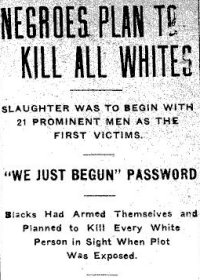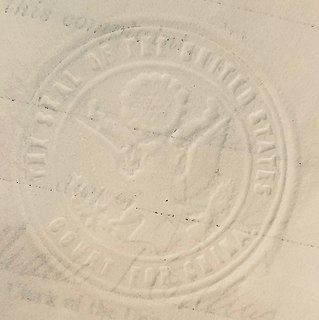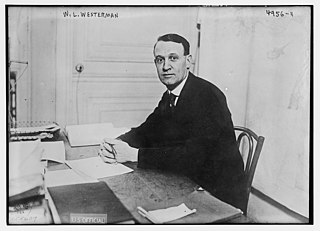
Clear and present danger was a doctrine adopted by the Supreme Court of the United States to determine under what circumstances limits can be placed on First Amendment freedoms of speech, press, or assembly. The test was replaced in 1969 with Brandenburg v. Ohio's "imminent lawless action" test.
Schenck v. United States, 249 U.S. 47 (1919), was a landmark decision of the US Supreme Court concerning enforcement of the Espionage Act of 1917 during World War I. A unanimous Supreme Court, in an opinion by Justice Oliver Wendell Holmes Jr., concluded that defendants who distributed flyers to draft-age men urging resistance to induction could be convicted of an attempt to obstruct the draft, a criminal offense. The First Amendment did not alter the well-established law in cases where the attempt was made through expressions that would be protected in other circumstances. In this opinion, Holmes said that expressions which in the circumstances were intended to result in a crime, and posed a "clear and present danger" of succeeding, could be punished.
Brandenburg v. Ohio, 395 U.S. 444 (1969), was a landmark decision of the United States Supreme Court interpreting the First Amendment to the U.S. Constitution. The Court held that the government cannot punish inflammatory speech unless that speech is "directed to inciting or producing imminent lawless action and is likely to incite or produce such action". Specifically, the Court struck down Ohio's criminal syndicalism statute, because that statute broadly prohibited the mere advocacy of violence. In the process, Whitney v. California (1927) was explicitly overruled, and doubt was cast on Schenck v. United States (1919), Abrams v. United States (1919), Gitlow v. New York (1925), and Dennis v. United States (1951).

The Elaine massacre occurred on September 30–October 1, 1919 at Hoop Spur in the vicinity of Elaine in rural Phillips County, Arkansas. Some records of the time state that eleven black men and five white men were killed. Estimates of deaths made in the immediate aftermath of the Elaine Massacre by eyewitnesses range from 50 to "more than a hundred". Walter Francis White, an NAACP attorney who visited Elaine shortly after the incident stated "... twenty-five Negroes killed, although some place the Negro fatalities as high as one hundred". More recent estimates of the number of black people killed during this violence are higher than estimates provided by the eyewitnesses, recently ranging into the hundreds. The white mobs were aided by federal troops and terrorist organizations like the Ku Klux Klan. According to the Encyclopedia of Arkansas, "the Elaine Massacre was by far the deadliest racial confrontation in Arkansas history and possibly the bloodiest racial conflict in the history of the United States".
Abrams v. United States, 250 U.S. 616 (1919), was a decision by the Supreme Court of the United States upholding the 1918 Amendment to the Espionage Act of 1917, which made it a criminal offense to urge the curtailment of production of the materials necessary to wage the war against Germany with intent to hinder the progress of the war. The 1918 Amendment is commonly referred to as if it were a separate Act, the Sedition Act of 1918.

The Reporter of Decisions of the Supreme Court of the United States is the official charged with editing and publishing the opinions of the Supreme Court of the United States, both when announced and when they are published in permanent bound volumes of the United States Reports. The reporter is responsible for only the contents of the United States Reports issued by the Government Printing Office, first in preliminary prints and later in the final bound volumes. The reporter is not responsible for the editorial content of unofficial reports of the Court's decisions, such as the privately published Supreme Court Reporter and Lawyers' Edition.
Debs v. United States, 249 U.S. 211 (1919), was a United States Supreme Court decision, relevant for US labor law and constitutional law, that upheld the Espionage Act of 1917.
Stromberg v. California, 283 U.S. 359 (1931), was a landmark decision of the US Supreme Court ruling 7–2 that a 1919 California statute banning red flags was unconstitutional because it violated the First and Fourteenth Amendments to the United States Constitution. This decision is considered a landmark in the history of First Amendment constitutional law, as it was one of the first cases where the Court extended the Fourteenth Amendment to include a protection of the substance of the First Amendment, in this case symbolic speech or "expressive conduct", from state infringement.
United States v. Darby Lumber Co., 312 U.S. 100 (1941), was a case in which the United States Supreme Court upheld the Fair Labor Standards Act of 1938, holding that the U.S. Congress had the power under the Commerce Clause to regulate employment conditions. The unanimous decision of the Court in this case overturned Hammer v. Dagenhart, 247 U.S. 251 (1918), limited the application of Carter v. Carter Coal Company, 298 U.S. 238 (1936), and confirmed the underlying legality of minimum wages held in West Coast Hotel Co. v. Parrish, 300 U.S. 379 (1937).

The United States Court for China was a United States district court that had extraterritorial jurisdiction over U.S. citizens in China. It existed from 1906 to 1943 and had jurisdiction in civil and criminal matters, with appeals taken to the U.S. Court of Appeals for the Ninth Circuit in San Francisco.

The Detroit Police Department (DPD) is a municipal police force responsible for the U.S. city of Detroit, Michigan.
Sinclair & Carroll v. Interchemical, 325 U.S. 327 (1945), is a United States Supreme Court decision that held a patent invalid for lack of inventiveness.
Chambers v. Maroney, 399 U.S. 42 (1970), was a United States Supreme Court case in which the Court applied the Carroll doctrine in a case with a significant factual difference—the search took place after the vehicle was moved to the stationhouse. The search was thus delayed and did not take place on the highway as in Carroll. After a gas station robbery, a vehicle fitting the description of the robbers' car was stopped. Inside were people wearing clothing matching the description of that worn by the robbers. They were arrested, and the car was taken to the police station where it was later searched.
Webb v. United States, 249 U.S. 96 (1919), was a United States Supreme Court case in which the Court held that prescriptions of narcotics for maintenance treatment was not within the discretion of physicians and thus not privileged under the Harrison Narcotics Act.
Frohwerk v. United States, 249 U.S. 204 (1919), was a United States Supreme Court case in which the Court upheld the conviction of a newspaperman for violating the Espionage Act of 1917 in connection with criticism of U.S. involvement in foreign wars.

Freedom for the Thought That We Hate: A Biography of the First Amendment is a 2007 non-fiction book by journalist Anthony Lewis about freedom of speech, freedom of the press, freedom of thought, and the First Amendment to the United States Constitution. The book starts by quoting the First Amendment, which prohibits the U.S. Congress from creating legislation which limits free speech or freedom of the press. Lewis traces the evolution of civil liberties in the U.S. through key historical events. He provides an overview of important free speech case law, including U.S. Supreme Court opinions in Schenck v. United States (1919), Whitney v. California (1927), United States v. Schwimmer (1929), New York Times Co. v. Sullivan (1964), and New York Times Co. v. United States (1971).

William Linn Westermann was an American historian and papyrologist who served as the president of the American Historical Association in 1944. He was regarded as an expert on the economy of the ancient world.

John Lord O'Brian was an American lawyer who held public offices in the administrations of five U.S. presidents between 1909 and 1945. O'Brian has been recognized by scholars for his commitment to civil liberties. At the time of O'Brian's death at the age of 98, Chief Justice Warren Burger described him as the "dean" of the bar of the Supreme Court of the United States.
Hess v. Indiana, 414 U.S. 105 (1973), was a United States Supreme Court case involving the First Amendment that reaffirmed and clarified the imminent lawless action test first articulated in Brandenburg v. Ohio (1969). Hess is still cited by courts to protect speech threatening future lawless action.
Banks v. Manchester, 128 U.S. 244 (1888), was a United States Supreme Court ruling dealing with copyright. In 1882, to facilitate the printing of records of the Supreme Court of Ohio, the state of Ohio passed a resolution to establish a copyright held by the Supreme Court of Ohio's court reporter and advertised the sale of the exclusive publishing rights to a lowest-bidding publishing company for the period of two years. H. W. Derby & Company won the bidding war and assigned all their right and interest in the contract to Banks & Brothers. Banks then contracted the Capital Printing and Publishing Company to print the books.








